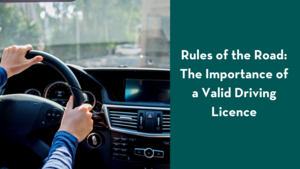In the intricate network of modern transportation, the driving licence emerges as a fundamental document, acting as a key to mobility and a symbol of individual freedom. Beyond being a legal requirement, a valid driving licence serves as a testament to one’s competence and responsibility as a driver. This comprehensive exploration delves into the significance of possessing a valid driving licence, emphasising its importance in ensuring road safety, legal compliance, and the overall well-being of both drivers and the broader community.
The Legal Foundation of Driving Licences:
1. Legal Mandate:
A valid driving licence is not merely a convenience but a legal mandate for individuals operating motor vehicles on public roads. In adherence to traffic regulations and safety standards, the possession of a valid licence is a prerequisite for anyone seeking to drive a car, motorcycle, or any other motorised vehicle.
2. Global Standardisation:
The concept of driving licences is not unique to any specific region but is part of a global effort to establish standardized rules for road users. Various countries have their own licensing systems, but they share common principles to ensure a consistent level of competency among drivers worldwide.
Road Safety and Competency:
1. Driving Skills Assessment:
Obtaining a driving license involves a rigorous process that includes both theoretical knowledge and practical driving skills assessments. This ensures that drivers are not only aware of traffic rules but are also capable of handling a vehicle safely in diverse road conditions.
2. Minimizing Accident Risks:
A valid driving licence signifies that the holder has demonstrated the necessary skills and knowledge to operate a vehicle responsibly. This competency contributes to minimizing the risks of accidents, enhancing overall road safety for the driver, passengers, and other road users.
3. Adherence to Traffic Regulations:
The process of obtaining a driving licence involves learning and understanding traffic regulations. Possessing a valid licence implies a commitment to following these rules, promoting orderly and predictable traffic flow, which is essential for preventing collisions and ensuring road safety.
Legal Compliance and Avoidance of Penalties:
1. Avoidance of Legal Consequences:
Driving without a valid licence is a serious offence that can lead to legal consequences. Possessing a valid licence not only establishes the driver’s legal eligibility but also helps in avoiding fines, penalties, and potential legal action.
2. Insurance Coverage:
In many jurisdictions, driving without a valid licence may void insurance coverage. This means that in the event of an accident, the driver may be held personally responsible for damages and injuries, further emphasizing the importance of maintaining a valid driving license.
Identification and Personal Accountability:
1. Positive Identification:
A driving licence serves as a universally accepted form of identification. It provides proof of the driver’s identity, reducing ambiguity and facilitating positive identification in various situations, such as routine traffic stops or other interactions with law enforcement.
2. Personal Accountability:
Possessing a driving licence fosters a sense of personal accountability among drivers. The process of obtaining a licence involves understanding the responsibilities that come with driving, reinforcing the importance of safe and responsible behaviour on the road.
Economic and Employment Opportunities:
1. Enhanced Employability:
Many professions require employees to possess a valid driving licence. Whether it’s a salesperson, delivery driver, or field service representative, having a licence enhances employability and opens up opportunities for a broader range of job roles.
2. Economic Independence:
A driving license contributes to economic independence by providing individuals with the means to commute to work, attend job interviews, and access employment opportunities that may be geographically distant. This is particularly crucial in areas with limited public transportation options.
The Process of Obtaining a Driving Licence:
1. Learner’s Permit:
The journey towards obtaining a driving licence typically begins with a learner’s permit. This phase allows individuals to learn driving under the supervision of a licensed adult before progressing to unsupervised driving.
2. Theoretical Knowledge Test:
To obtain a driving licence, individuals are required to pass a theoretical knowledge test, demonstrating their understanding of traffic rules, road signs, and safe driving practices.
3. Practical Driving Test:
The practical driving test assesses the applicant’s ability to operate a vehicle safely in various traffic conditions. It includes tasks such as parking, manoeuvring, and navigating intersections.
4. Issuance of Licence:
Upon successfully completing both the theoretical and practical components, a driving licence is issued. The type of licence may vary based on the vehicle type and other factors, such as commercial or non-commercial driving.
Suggested reads : Driving licence renewal
Conclusion:
A valid driving licence is more than just a laminated card; it is a testament to an individual’s commitment to road safety, adherence to traffic regulations, and personal accountability as a driver. Beyond legal compliance, it opens up economic opportunities, enhances employability, and contributes to overall societal well-being. As technology continues to shape the future of transportation, the essence of a valid driving licence remains a cornerstone in ensuring a safe, efficient, and responsible driving culture on the roads. Obtaining and maintaining a driving licence is not just a legal obligation; it is a crucial step towards creating a safer and more sustainable transportation ecosystem for everyone on the road.






